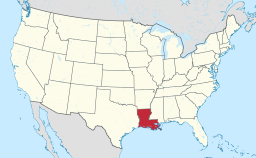Hornbeck, Louisiana
| Hornbeck, Louisiana | |
| Town | |
| Motto: "Gateway to Toledo Bend" | |
| Country | United States |
|---|---|
| State | Louisiana |
| Parish | Vernon |
| Elevation | 325 ft (99.1 m) |
| Coordinates | 31°19′33″N 93°23′45″W / 31.32583°N 93.39583°WCoordinates: 31°19′33″N 93°23′45″W / 31.32583°N 93.39583°W |
| Area | 1.2 sq mi (3.1 km2) |
| - land | 1.2 sq mi (3 km2) |
| - water | 0.0 sq mi (0 km2), 0% |
| Population | 435 (2000) |
| Density | 372.9/sq mi (144.0/km2) |
| Founded | October 21, 1902 |
| Government | Mayor-Council |
| Timezone | CST (UTC-6) |
| - summer (DST) | CDT (UTC-5) |
| Postal code | 71439 |
| Area code | 318 |
|
Location in Vernon Parish and the state of Louisiana.
|
|
|
Location of Louisiana in the United States
|
|
| Website: Town of Hornbeck, Louisiana | |
Hornbeck is a town in Vernon Parish, Louisiana, United States. The population was 435 at the 2000 census. It is part of the Fort Polk South Micropolitan Statistical Area.
As early as the 1830s people settled in the area now known as Hornbeck, but a town didn’t begin to form until 1897, when an agent for the Arkansas Town Site Company named F.A. Hornbeck purchased land along the Kansas City Southern Railroad (KCS) for $8,640. Structures necessary for servicing locomotives were constructed as well as a brick kiln to supply bricks for construction.
In 1897, the first Post Office opened in the area with Walter Carey as the first postmaster and later that same year he was succeeded by D.B. Pate.
The first public school in Hornbeck opened in 1898, with Miss Fannie Monk and W.L. Ford serving as the primary and grammar school teachers. The first secondary school opened in 1907 with G.S. Graybeal serving as its principal, then in 1910 the school became an affiliated high school.
On October 21, 1902, Governor William Wright Heard issued a proclamation declaring that Section 16, Township 4, North Range 10 West was incorporated as Hornbeck; with W.M. Conerly appointed mayor and G.G. Leach, W.L. Maddox and John Carter appointed aldermen; W. Johnson became the town marshal.
Kansas City Southern Railroad established a presence in Hornbeck with the construction of the roundhouse, which allowed for the servicing of engines. The presence of the roundhouse contributed to making Hornbeck a significant junction between Port Arthur, Texas and Shreveport as well as providing an abundance of jobs and influencing the town’s growth. The early twentieth century was a prosperous time for Hornbeck with both the timber and railroad industries having an established presence in the area. Hornbeck became a bustling little town, with a bank, a newspaper, five hotels, five saloons and ten retail stores.
...
Wikipedia


